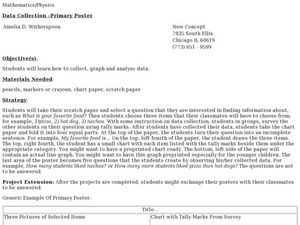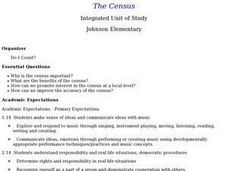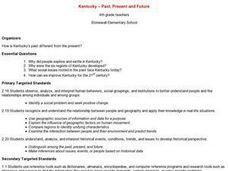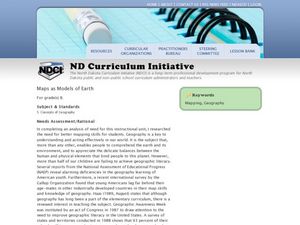National Endowment for the Humanities
How "Grand" and "Allied" Was the Grand Alliance?
Learn more about the Grand Alliance with a scaffolded lesson plan that includes four activities. Class members use primary sources to complete a map exercise, understand the goals and objectives of each individual nation, and participate...
Smithsonian Institution
For Land's Sake: George Washington as Land Surveyor
Students discuss the importance of land ownership and the purpose of land surveying in the eighteenth century. They interpret a transcript of an eighteenth-century land survey. They survey and area of land. They create a written or...
Curated OER
Data Collection - Primary Poster
Students explore the concept of collecting, analyzing, and graphing data. In this collecting, analyzing, and graphing data lesson, students create a survey about a topic of interest. Students poll their classmates, analyze, and graph...
Curated OER
Career Interest Record Update
Second graders complete a Career Interest Record and compare it to their record from the previous year to see how they have changed.
Foreign Policy Research Institute
Ancient and Medieval China
This is a thorough lesson plan on Chinese history that includes readings from primary and secondary sources, guided reading questions, videos, and a take-home final assessment. While it indicates an audience from 9th through 12th grade,...
Curated OER
Bar Graphs and Pie Charts
Fourth graders explore their interest and strengths and display them using a bar graph and pie chart.
Code.org
Introduction to Data
Data, data everywhere. Challenge your class to begin thinking about data, the ways people collect information, and what we can learn from this data. Class members discuss sources of data and then individuals answer questions in the class...
Curated OER
The Shadow
Students identify career areas which are nontraditional for their gender. They tak a self-assessment survey type instrument that indicates the primary type of intelligence as based on the Multiple Intelligence Theory (Howard Gardner).
Virginia Department of Education
Calculating Measures of Dispersion
Double the fun — calculate two measures of deviation. The lesson plan provides information to lead the class through the process of calculating the mean absolute deviation and the standard deviation of a data set. After learning how to...
Curated OER
Data Collection
Learners investigate qualitative and quantitative data. In this statistics lesson, students gather data on heights and weights of people and graph the distribution. Learners discuss the differences between qualitative and quantitative data.
Curated OER
The Seasonal Round and The Cycle of Life
Fourth graders are introduced to the concept of the seasonal round and how folklife traditions vary from season to season. They begin charting dates of personal interest on seasonal round calendars by starting with birthdays. Students...
Curated OER
Careers in Mining
Students examine the different careers related to mining. They watch and discuss a video, take a survey of interests and discuss the mining careers that they might be interested in, and create a drawing of themselves doing one of the...
Curated OER
Finding Out-- Forest Researchers
In this social studies and science worksheet, students study facts about the forest, creatures who inhabit the forest and those who work in forestry. Students complete 20 questions including word meanings, surveying classmates, matching...
Curated OER
The Census
Students analyze why the census is important and the benefits of it. Determine rights and responsibilities in real life situations. They are divided into groups and take a mock census of a list of teachers and students each. Results of...
Curated OER
Social Sstudies: Change in Space and Time
Students examine the dynamics of change and compare and contrast it with other cultures. They cite examples of how people change over time and explain why it is necessary. Students organize a skit, Webpage, or Powerpoint presentation...
Curated OER
Kentucky: Past, Present and Future
Fourth graders analyze how Kentucky's past is different from the present. They research why Kentucky was even explored and settles. What social issues face Kentucky now. Discussion lies on how Kentucky can be improved for the 21st century.
Curated OER
Maps as Models of Earth
Eighth graders use different types of maps to find locations and surface features. For this map-reading lesson students use a compass to find direction.
Curated OER
Trips as Cheap as Chips
Students take part in summer activities. In this field trip opportunities lesson plan, students may visit California Country Park, the Victoria and Albert Museum, the Manchester Art Gallery, the Princess Diana Memorial Playground, or...
Curated OER
Finding an Earthquake's Epicenter
Students examine the process used to identify the epicenter of an earthquake. They identify the Richter scale and interpret a seismograph reading. They also view photographs of the aftermath of earthquakes.
Curated OER
Where Have All the Endangered Gone?
Students explore animals that are endangered. They choose an endangered animal that they would like to keep from becoming extinct. Students create a persuasive presentation to persuade someone to understand why they feel keeping their...
Curated OER
Researching Intermountain West Earthquakes
Students research earthquakes using the internet and newspapers. They discover the earthquake's effect on people and buildings. They report their findings to the class.
Curated OER
Who Works Here?
Fourth graders list all of the workers in their school. They interview them to find out more about each occupation.























